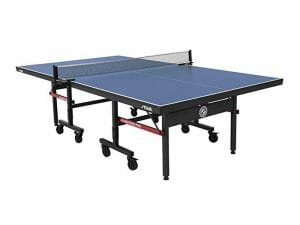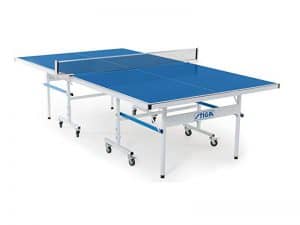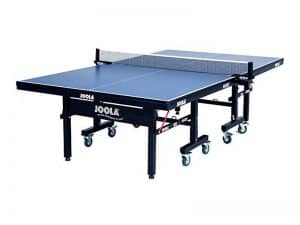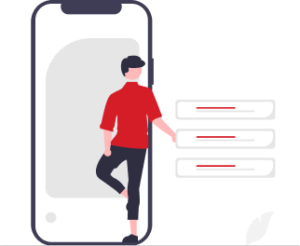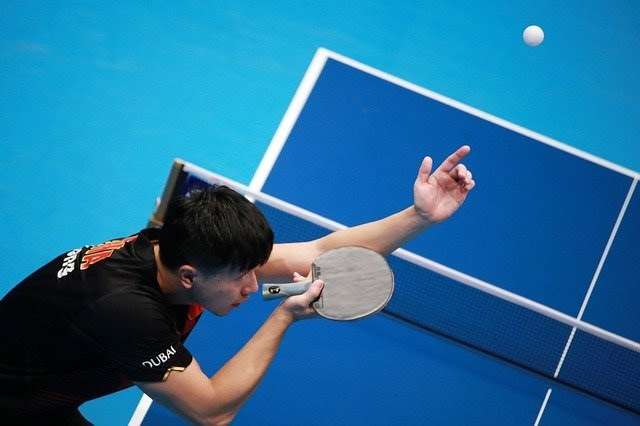Pickleball Strategy for Doubles: Become an Elite Partner!
- Alex Horscroft
- Last updated
While it can be tempting to pick up a pickleball paddle and play right away, this is a recipe for disaster.
To excel, you need an effective pickleball strategy for doubles. But unless you’ve studied the game, you wouldn’t know what an effective pickleball strategy is. Therefore, the first step is learning what works in pickleball and what doesn’t.
These are 16 pickleball strategies for doubles that will help you to improve:
- Approach the kitchen as quickly as possible
- Don’t stand too close to the baseline when returning serves
- Prevent your opponents from approaching the kitchen
- Serve deep
- Keep the ball low
- Communicate at the crossover
- Don’t miss serves
- Play wide and down the middle
- Placement trumps power
- Move as a unit
- Aim for your opponent’s feet
- Become a dinking pro
- Become effective poachers
- Don’t lob too much
- Make use of drop shots
- Use your forehand where possible
- Exercise patience
But without the details, you won’t be able to take your game to the next level. Read on to learn everything about doubles strategy for pickleball.
Pickleball Strategy for Doubles Explained
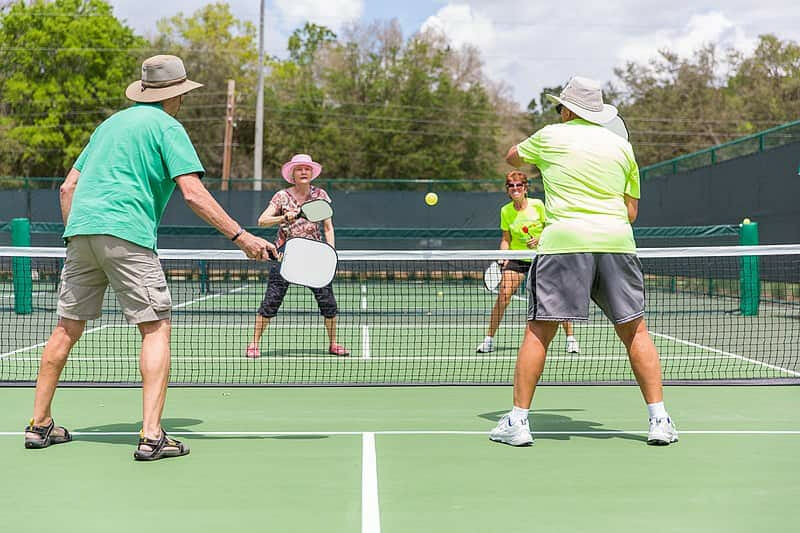
TheVillagesFL (Wikimedia Commons) under CC BY-SA 4.0 – unedited
1. Approach the Kitchen As Quickly as Possible
If there’s one strategy for pickleball that trumps all others, it’s that just outside of the kitchen is the area you want to be. This is because you have more offensive options when standing here.
You can play powerful shots to the back of the court, volleys, lobs, you name it. And your opponent has less time to react than if you were at the back of the court because the ball travels a shorter distance.
The players at the kitchen won rallies far more often than those who are further away, so get close to the kitchen as soon as possible. The double bounce rule means that each team has to let the ball bounce once before volleys are permitted. So don’t rush to the net until you can volley the ball.
2. Don’t Stand Too Close to the Baseline When Returning Serves
It’s easy to get a bit trigger-happy when it comes to approaching the net, and as such, many of us stand too close to the baseline in anticipation of our charge. This is a foolish mistake to make.
Standing really close to the baseline when returning serves provides no competitive advantage.
This is because you can’t rush the net due to the double bounce rule! If you stand too close, deep serves will have you backpedaling and off balance, increasing the likelihood of you losing the point.
Instead, take a few steps back. This way you can easily cover both deep and short serves. Remember, you can travel quicker going forward than backward.
3. Prevent Your Opponent’s From Approaching the Kitchen
Just as you want to approach the kitchen in doubles pickleball, so do your opponents. Look at them. They’re practically drooling at the prospect.
And as we know, when you are positioned just outside of the kitchen, your win odds increase. Therefore, while your goal is to approach the net, you must do everything possible to stop your opponent from getting there.
The easiest way is to keep your shots fast and deep. You’ll also want to play wide, which adds some unpredictability into the mix. Most of the time you’ll want to avoid drop shots as this gives your opponents a free pass to approach the net.
4. Serve Deep
While your opponents can’t rush the net because of the double bounce rule, you’ll still generally want to play deep serves. This is because it affects their position for their follow-up shot, making it harder for them to approach the net.
It also increases the window until you need to hit the ball next, giving you more freedom to play a higher-quality shot.
5. Keep the Ball Low
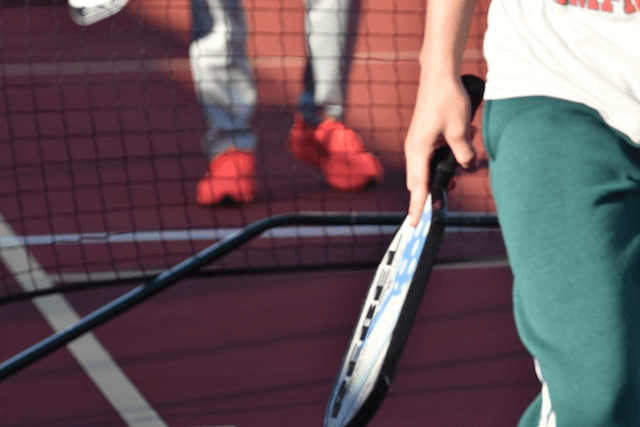
As with all racket sports, shots that narrowly clear the net are harder to return than high ones. This is because of two reasons.
Firstly, the ball has a more direct flight path, reaching its destination quicker.
And secondly, due to the decreased verticality, the ball has a shallower bounce. This ultimately makes it harder to make a return — especially a point-ending power shot.
Read More: Pickleball Rules for Doubles
6. Communicate at the Crossover
The most frustrating mistakes you can make in pickleball doubles are needless — circumstances where you have every opportunity to make a sound return.
These preventable mistakes occur nowhere more often than at the crossover between you and your opponent. The reason for this is there will be times when each of you expects the other person to hit the ball, but they don’t. Or, you both might go for the same ball and make a mess of it.
Therefore you must communicate clearly with your opponent to avoid these needless mistakes. Quick phrases like ‘Mine’, ‘Yours’, ‘Me’, and ‘You’ tend to be the go-to.
Beyond this, a good pickleball doubles strategy is to set conditions with your partner before games, such as one person taking all central shots to avoid confusion.
7. Don’t Miss Serves
Unlike tennis and ping pong where serves hold a lot of influence, pickleball is rather the opposite. Serves are more just a means to get the rally going, therefore, you should prioritize just getting your serves in rather than trying to win the point.
If you don’t, you’ll likely lose more points in the long run as only the best serves can frequently force mistakes out of opponents. And remember! There are no second serves in pickleball!
8. Play Wide and Down the Middle
Playing the ball centrally is an easy way to force mistakes out of your opponent. This may seem counter-intuitive, but it works! As discussed earlier, central balls can be troublesome if a pair has poor communication, so focus a good chunk of your balls there.
You should also play your fair share of balls wide to get your opponents moving and open up angles for you to hit winners.
9. Placement Trumps Power
We all love to smash the ball, but forcing smashes that aren’t there to hit is a bad idea. In fact, most of the time, rallies are won through errors rather than quality shot-making.
From this, we can conclude that consistency trumps power. Therefore lean on placement as a means to keep yourself safe and your opponents under pressure.
Aiming for the middle is always a sound strategy. This is because you simultaneously force your opponents to communicate and avoid the wide shots where you risk hitting the ball out of bounds.
Another great target is to aim for your opponent’s backhand. Backhand is more difficult to hit than forehand, and it is also less powerful.
10. Move as a Unit
When playing pickleball with a partner, you need to move as a unit — a bit like you’re part of the same hivemind. If you don’t, gaps will open up, which your opponents can easily exploit.
So if your partner approaches the net, guess what. You approach.
And if your partner moves wide to the left, you move to the left also to cover the space they created.
The key to success when it comes to movement is to follow the motion of the partner who is hitting the ball. You only move when they move. Not before.
Read More: How to Play Pickleball
11. Aim For Your Opponent’s Feet
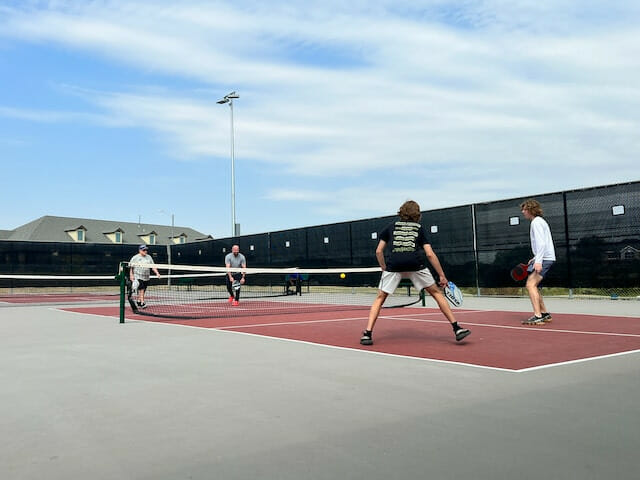
While central and wide shots are great places to hit the ball, they are fixed positions. However, there are constantly changing positions which are equally effective areas to aim for.
I’m talking about your opponent’s feet. It may seem strange, but a ball that lands near your feet is difficult to hit. It’s tough to move your legs in time to make the shot, and as a result, balls tend to pop up high which are ripe for punishing. You’ll see all high-level players using this pickleball strategy for doubles.
12. Become a Dinking Pro
Dinks are a very common shot in pickleball, so you best become an expert at performing them!
To hit better dinks, you want to keep the ball low and ensure it lands in the kitchen. This way your opponents can’t do much offensively.
However, you should go much further than this. Try to fake your placement, use a variety of spin, aim at your opponent’s feet, and do whatever else you can to force a mistake.
13. Become Effective Poachers
Poaching is an advanced pickleball doubles strategy that requires you to have good game awareness. When you find that one of you is close to the kitchen and the other is deep, you can usually be pretty certain where your opponents want to place the ball. It’s the space in front of the deep player.
This provides a great opportunity for the player near the kitchen to quickly move over to the partner’s half to poach the ball. If performed correctly, it usually results in a winner. However, if used poorly, you may get punished to the area the player opened up by trying to poach the ball.
14. Don’t Lob Too Much
Used sparingly, lobs are great shots in pickleball. They are superb at disrupting rhythm and forcing your opponent away from the kitchen. However, you will likely get punished if you use them too much.
Lobs work best when your opponents are not expecting them, and when executed at the right time, you might even get away with a poor-quality lob.
They are also much riskier than your standard groundstrokes. You have to get just the right amount of height and depth, which is tricky.
15. Make Use of Drop Shots
Drop shots are another shot that is difficult to get right but one you should certainly invest time into. They are ideal when your opponents are beside the kitchen but you are not. A drop shot allows you to approach the net without getting punished, eliminating the advantage your opponents previously had.
Yet, like lobs, drop shots are fairly difficult to get right. This is mostly because your opponents will be blasting powerful balls your way, and it’s very difficult to kill the ball’s pace and get it to land in the kitchen. It requires a lot of finesse, and you must choose the right depth to play the shot.
16. Use Your Forehand Where Possible
Forehand is more powerful than backhand, so incorporate this knowledge into your pickleball strategies for doubles. Whenever a ball lands at your crossover, always move your feet so that you can do a forehand stroke.
Similarly, when a ball lands down the middle between you and your partner, it is advisable for the player who can use their forehand to play the shot.
Overall, you should use your forehand far more often than if you were playing singles. This is because you only have to cover half of the court for the doubles system. Thanks, partner!
Read More: Pickleball Rules for Singles
Final Thoughts for Doubles Pickleball Strategy
Pickleball may look easy, but when you play against an experienced pair who knows what they are doing, reality hits hard really fast! So try to incorporate as many of these 16 pickleball strategies for doubles as you can.
As a parting reminder, we want to reiterate communication’s importance before and during play. Form strategies with your partner before game time, agree on who takes the central balls, and when you find yourself in a tough game, try and exercise positivity. Nobody wants to play doubles with somebody who is constantly insulting them.
Other Interesting Reads
- Pickleball Court Dimensions
- The Best Pickleball Paddles You Can Buy
- The 5 Best Pickleball Sets You Can Purchase
Freelance writer. Table tennis enthusiast. Lover of all things online. When I’m not working on my loop game I’m probably binge-watching some fantasy show.
-
Alex Horscrofthttps://pingpongruler.com/author/alex-horscroft/
-
Alex Horscrofthttps://pingpongruler.com/author/alex-horscroft/
-
Alex Horscrofthttps://pingpongruler.com/author/alex-horscroft/
-
Alex Horscrofthttps://pingpongruler.com/author/alex-horscroft/
Popular Products
Join our email list for exclusive reviews & the latest Ping Pong News
Sign up to our newsletter and stay up-to-date with the latest news in the ping pong world, and be the first to read our new product reviews. We promise, no spam







